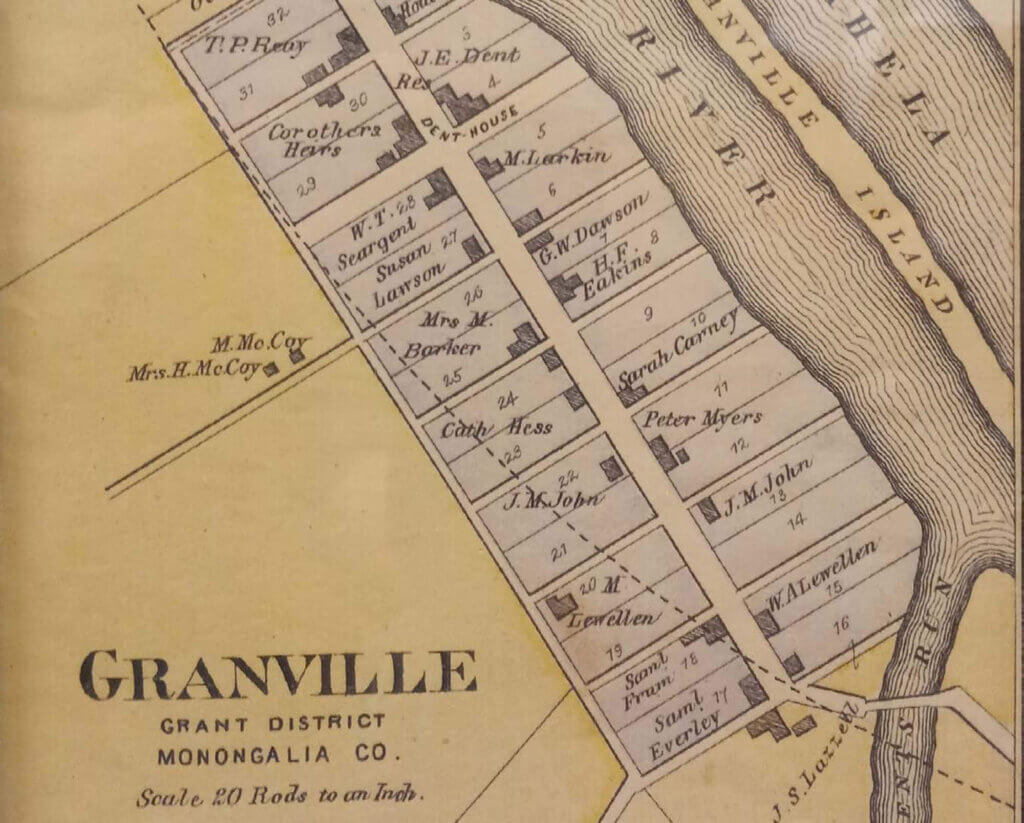You’ve propbably shopped at the University Town Centre part of Granville—but have you visited its historical Main Street, 1,000 feet below?

Every June in the 1950s and ’60s, the Thomas Joyland Shows lit up Granville’s Main Street. It was all a carnival can be: the smells and tastes of fried fair food, the strains of uptempo music, the calls of hawkers peddling their sideshows and games and rides. People came from counties all around.
“We’d always save our money up for Saturday, because then it was 10 cents a ride,” Granville Town Councilman David Bean remembers. “You could ride 10 rides in a day. That was something.” Genevieve Calvert’s house looked on the carnival grounds. She loved the cotton candy, and the “hoochie coochie shows” gave her her sex education. “People would come out the back door and do whatever they wanted to do—and we were looking right out of our windows!” When the carnival closed, kids scrounged for pop bottles and took them to Michael’s or Derrico’s grocery store to collect the deposits.
The rest of the year, the carnival ground was the ballfield, where there were always enough kids hanging out to get a game of baseball, football, or basketball going, says Allen Michael, son of the grocers. It was a great place to grow up. “You would leave in the morning, and you’d be home for dinner,” Calvert says. “Your parents didn’t worry. You just went and went—you were having a good time.”
Over 200 years old, Granville saw its fortunes rise in the 1900s with the coal industry, then fall with it, too, as the century closed. Its fortunes are rising again. Many Morgantown-area residents may not be able to find old Granville on a map—but that is about to change.
Origins
In 1814, when Morgantown was 30 years old, Felix Scott got a charter from the state of Virginia to establish “Grandville” across the Monongahela from Morgantown and two miles downriver. Scott laid out 30-some lots on a flat place between the river and the hill at the mouth of Scotts Meadow Run—now Dents Run. He left in 1816 to take some pioneers to Missouri and eventually made his way to the Oregon Territory. But the little town he left behind thrived.
The new riverside settlement occupied a choice spot on the road between the busy county seat of Morgantown and the Ohio River to the west, and, by the 1830s, more than 100 people made it their home. The economy hummed with a saddler, a smithy, a cooper, and boot and cabinet makers, plus dry goods stores, a school, and a post office.
Soon after West Virginia calved off of Virginia in 1863, Granville received an enduring distinction: Its own Marmaduke Herbert Dent, a great-grandson of distinguished early settlers, earned the first degree awarded by the new land grant West Virginia University, in 1870. Dent went on to become a judge of the West Virginia Supreme Court of Appeals.
Granville expanded gradually northward and up the lower slopes of the steep hill at its back side. But its real growth came with development of the rich Pittsburgh coal seam along the west side of the river, including within the hill behind town. When the Monongahela Railway came through in 1912 to haul Mon Valley coal north to the mills and foundries that would build the region, mining flourished. Workers followed, from the southern U.S. and from all over Europe—Hungarians, Italians, Ukrainians, Scots, and others.
Granville was small, but well-connected. After about 1890, residents could flag a packet steamboat on the Mon River. A trolley line opened in 1910, connecting Morgantown through Granville with the mining communities beyond. By the 1920s, residents could wave down trains to Fairmont or Pittsburgh and points between any day of the week. And in 1921, a grand, 16-foot-wide concrete road was laid through town, with frequent Star Bus Company runs between Morgantown and Scotts Run.
Mid-century was a heyday for old Granville, and it celebrated its success in 1947 by becoming the seventh town incorporated in the county, with a population pushing 1,000.
Mid-century
Coal was central to mid-1900s life in Granville: trucks and trains hauling it through, a belt line carrying it over the road to waiting barges, families collecting what fell off the trains to heat their homes in winter. Most Granville livelihoods came from the mines or the railroad.
But the town buzzed with local concerns, too—a barber shop here, a watering hole there, a sawmill. Mahalick’s diner at Dent’s Run had at least one big draw. “My mother would go to work there in the morning and make the most wonderful donuts ever,” Calvert remembers. “They would sell out every day.” DeCarlo Discount House on Main Street, established in the 1950s as possibly the first discount retailer in the state, became a destination for avid bargain-hunters from Morgantown and all around. Koval Building and Plumbing Supply opened in 1963, and a House of Cards Hallmark shop came in the 1970s.
Public school students attended Granville Elementary right in town, then Riverside Junior High School in Westover and University High in Morgantown. Michael went to St. Francis on Beechurst for the middle grades and on Patteson Drive in Suncrest for high school. He rode two buses each way, but sometimes he preferred to walk home across the Star City bridge, which opened in 1956. It seems far today, but good pedestrian access to the bridge and a path to the railroad tracks made it well under three miles.
Kids took odd jobs and worked in shops to make money for their school clothes, Bean says. He and Michael had paper routes—Michael delivered the Dominion News in the mornings, and he took the Morgantown Post in the afternoons.
But in spite of the hard work, what residents who grew up there remember most is long days of play with friends. Besides pick-up games, Michael remembers horseshoes and, on the quiet side streets, marbles and hopscotch, and kick the can in the evenings. Sometimes kids walked to Westover Park, and the arrival of a traveling roller skating pavilion was a highlight. Parents drove older kids to Riverside Park, downriver near today’s Fort Martin Boat Launch, to spend the day at the swimming pool. On snowy days, Bean remembers sled riding on the hill above the town.
Mid-century Granville was close-knit and self-sufficient. Families kept up with each other at church, and Granville men—Bean and his dad, and Michael, and many others—helped out at the volunteer fire department. Unless they went to school or worked across the river, residents really only went “over town” to buy clothes, go to the theater, or have a special meal out.
The 1995 closure of CONSOL Energy’s Arkwright and Osage mines changed Granville’s fortunes dramatically. Families lost their livelihoods, and Granville’s operating budget was cut in half.
But in a move that proved inspired, the town annexed the CONSOL property that lay on the hill above town.
Life After Coal
In 2005, Best Buy and Target opened as the first stores at University Town Centre, the beginnings of “upper” Granville. The town committed to providing police and fire protection and street maintenance as the shopping center grew. And grow it did, into miles of shopping, dining, lodging, and entertainment.
With the taxes that have flowed into Granville’s coffers, it has upgraded its municipal services equipment and now offers residents in the lower town faster police response and snow removal than they’ve ever had. “The town didn’t have the money before, plain and simple,” Bean says. “Now we’ve got enough to give back to the people.” A new park with girls’ softball fields, tennis, basketball, picnic pavilions, and a playground is among the nicest in the region. “We have community days and movies in the park. And we’re getting ready to build a riverfront park with a boat ramp so people can launch their boats.”
Some of the enterprise that built 1900s Granville still shapes greater Morgantown today. The DeCarlos’ earlier ventures for example: The family founded DeCarlo Wholesale in Westover earlier in the century as well as Mona Supply grocers and beer distributors in Granville, in the building that is now Granville Town Hall. DeCarlo Wholesale became Chuck’s Furniture, and Mona Supply operates today from a warehouse out past Sabraton. And, of course, Granville’s Koval Plumbing and Building Supply became Koval Building Supply, operating now at locations in Granville and Morgantown and in Uniontown, Pennsylvania.

Mid-century natives remain attached. Calvert recently served on Granville Town Council, and Bean still does. Michael established City Office Supply on High Street in Morgantown in the 1980s while his wife, Charlotte, also a Granville native, ran Office Shopper’s Paradise in the old DeCarlo Discount House buildings. They’re among many whose good feelings for the Granville they grew up in have kept them connected there throughout their lives.
In 2020, New South Media, the publisher of this magazine, proudly became part of Granville’s story by establishing New South Square on Main Street in the former DeCarlo Discount House and Office Shopper’s Paradise warehouse complex. Appalachian Mercantile General Store and Cafe opened recently in one of the storefronts, and Appalachian Salvage will soon be open weekends with architectural finds from across the region. An event space, The Silo in the Square, will soon follow.
Town founder Felix Scott’s instincts continue to work well for this town that is easy to get to and just far enough from bustling Morgantown to maintain its own small-town culture and identity.















Leave a Reply